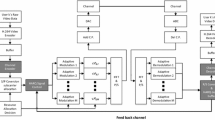Abstract
There are three kinds of channel coding schemes for uplink control information (UCI) with different sizes in long term evolution (LTE) system: the block codes with length of 20 and 30 bits as well as tail-biting convolutional code (TBCC) with rate of 1/3. To reduce complexity, a unified design of 1/5 TBCC using two-level puncture is proposed for all different sizes of UCI in this paper. Compared with LTE design, the proposed design is much simpler since there is only one channel encoding scheme in user equipment (UE) and only one decoding algorithm in base station. In addition, the first three generators of the proposed 1/5 TBCC are the same as that of the TBCC in LTE, thus the proposed design is backwards compatible with the original design in LTE. Simulation results show that the frame error rate performance of the proposed two-level punctured TBCC is close to or even better than that of the original block codes with lower decoding complexity.







Similar content being viewed by others
References
Kumar, A., Sengupta, J., & Liu, Y. (2012). 3GPP LTE: The future of mobile broadband. Wireless Personal Communications, 62(3), 671–686.
Fan, J., Yin, Q., Li, G. Y., Peng, B., & Zhu, X. (2011). Adaptive block-level resource allocation in OFDMA networks. IEEE Transactions on Wireless Communications, 10(11), 3966–3972.
Zhaogan, L., Yuan, R., Taiyi, Z., & Liejun, W. (2010). Multiuser MIMO OFDM based TDD/TDMA for next generation wireless communication systems. Wireless Personal Communications, 52(2), 289–324.
Wong, I. C., Oteri, O., & Mccoy, W. (2009). Optimal resource allocation in uplink SC-FDMA systems. IEEE Transactions on Wireless Communications, 8(5), 2161–2165.
GPP TS 36.212 v12.0.0. (2013). 3rd Generation Partnership Project; Technical Specification Group Radio Access Network; Evolved Universal Terrestrial Radio Access (E-UTRA); Multiplexing and Channel Coding (Release 12).
Donthi, S. N., & Mehta, N. B. (2011). An accurate model for EESM and its application to analysis of CQI feedback schemes and scheduling in LTE. IEEE Transactions on Wireless Communications, 10(10), 3436–3448.
GPP TS 36.212 V8.7.0. (2009). 3rd Generation Partnership Project; Technical Specification Group Radio Access Network; Evolved Universal Terrestrial Radio Access (E-UTRA); Multiplexing and Channel Coding (Release 8).
Ma, H., & Wolf, J. (1986). On tail biting convolutional codes. IEEE Transactions on Communications, 34(2), 104–111.
(Jason) Chen, T.-T., Yu, K., Sjöberg, S., Östling, P.-E., & Ericsson AB, P.-E. (2009). Tail-biting convolutional codes with expurgation and rate-compatible puncturing for the secondary fast feedback channel. Paper submitted to Project 802.16 m amendment working document (AWD) content.
Morelos-Zaragoza, Rober H. (2006). Art of error correction coding (2nd ed.). New York: Wiley.
Shao, R. Y., Lin, S., & Fossorier, M. P. C. (2003). Two decoding algorithms for tailbiting codes. IEEE Transactions on Wireless Communications, 51(10), 1658–1665.
Chen T. T., & Tsai S. H. (2008). Reduced-complexity wrap-around Viterbi algorithm for decoding tail-biting convolutional codes. In Wireless conference, 2008. EW 2008. 14th European, pp. 1–6.
Viterbi, A. (1967). Error bounds for convolutional codes and an asymptotically optimum decoding algorithm. IEEE Transactions on Information Theory, 13(2), 260–269.
Acknowledgments
This work was supported by the Natural Science Foundation of China under Grant (51274018), the National Science and Technology Pillar Program (2013BAK06B03), and Korea Research Council for Industrial Science and Technology (B551179-12-07-00).
Author information
Authors and Affiliations
Corresponding author
Rights and permissions
About this article
Cite this article
Yang, W., Zhang, L., Yang, Z. et al. A unified design of channel coding for LTE uplink control information. Wireless Netw 21, 1661–1667 (2015). https://doi.org/10.1007/s11276-014-0879-7
Published:
Issue Date:
DOI: https://doi.org/10.1007/s11276-014-0879-7




